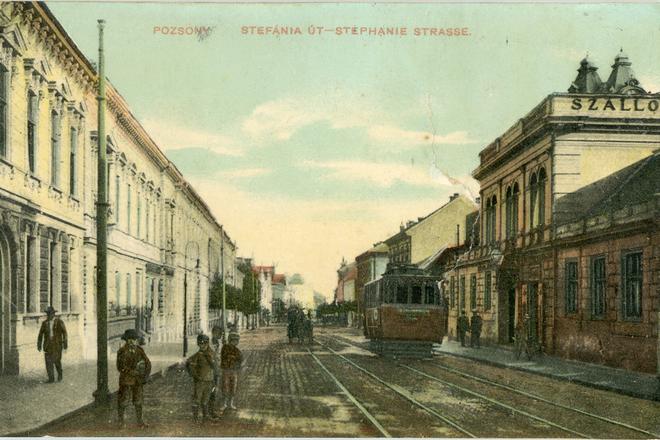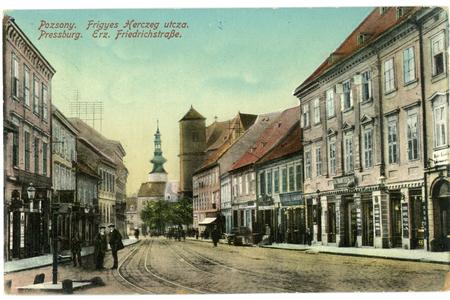Read and see in this article:
-History of palaces built on Štefánikova Street
-In which building the Freemason lodge used to meet
-See historical photos of Štefánikova Street
-See how the street looks like today
It used to be an ordinary field road leading via the vineyards out of town to the regions of Záhorie and Moravia. Later, aristocracy and city notables began to build their settlements on the then city’s outskirts and set up gardens. The first was the Summer Archbishop’s Palace, today’s Government office, with a garden. A few decades later, Grassalkovich, today’s presidential palace, was added. Even later, at the far end of the street, Palugay Palace was built, which now serves the Ministry of Foreign Affairs.
The importance of the street increased significantly in the second half of the 19th century, when the train station of the steam railway was constructed near the site of today’s Main Station. At that time, today’s Štefánikova Street became the gateway to the city, because when someone got off the train, this was the shortest way to its centre.
“It was a link between the city and the world,” said Ján Vyhnánek from the civic association Bratislavské Rožky, at the beginning of a lecture on this part of Bratislava in late February. “Gradually, splendid buildings were constructed here, and it became a representative boulevard, which has retained some of its original features to this day.”
How did the names of Štefánikova Street change?
1701-1885 - Märzel Gasse and several variations, according to the old vineyard bed
1885-1921 – Štefániina Road, named after the Belgian Princess Stephanie, who lived in Rusovce
1921-1950 - Štefánikova Street after M. R. Štefánik
1950-1968 – Obrancov Mieru Street (Street of the Defenders of Peace in English)
1968-1973 - Štefánikova Street
1973-1990 - Obrancov Mieru Street
1990-today - Štefánikova Street, bust of M. R. Štefánik is set on the façade of the the Slovak Academy of Sciences building
Source: Database of historian Tivadar Ortvaya
The boulevard owes its architectural look to the local design and construction company Kittler and Gratzl of Ferdinand Kittler and Karol Gratzl, and the builder Alexander Feigler. It was they who designed and built most of the buildings still standing on this street. In addition to their eclectic buildings, architect Jan Víšek left a footprint of modern, functionalistic architecture.
The importance of the boulevard was further emphasized by the launch of a tram line in 1895. Until 1979, those interested could take the tram from the station to the city through Štefánikova.
Stefánka café
At the very beginning of the street in the direction out of the city, there lies one of the most famous cafés in the city, Štefánka, although its address is actually Palisády Street 59. It was created in the parterre of a rental house, designed and built by Alexander Feigler in the years 1896-1897 for Count Irma Erdődyová. Rosa Dresdner was the first to operate the café, already at the end of 1897. She offered an English breakfast as an extraordinary specialty, which she used to serve already in a spa in the High Tatras.




